Optimizing Your Digital Business Model
What does it take to create the strongest possible online presence?
Topics
Are your customers leaving you behind digitally? Are they seeking out other companies that provide great digital customer experiences?
These are far from idle questions. Customers are increasingly demanding to interact with companies anytime and anywhere. For instance, 72% of customers in a recent survey said they would replace some traditional channels with mobile apps if the capability was available.1
Given that, enterprises must strengthen their digital business models — how they engage their customers digitally to create value, via mechanisms such as websites and mobile devices.2 If your company doesn’t offer a great digital experience, many customers, particularly younger people, will move to industry competitors or do more business with companies like Amazon.com that offer great customer experiences digitally, operate in adjacent industries and are starting to offer services similar to yours.
To make this change more difficult, a great digital business model challenges the traditional physical business model that relies on places (such as bank branches, bookstores or department stores) and people (such as sales teams or insurance agents) to delight a customer. A digital business model challenges the physical model in three main areas: internal power, since who “owns” the customer’s experience often changes from product groups to the unit that manages the multiproduct customer experience; business processes, which require rethinking to be seamless across channels; and customer data, which become an enterprise-wide resource rather than remaining hidden in one area.
Whether you are a born-on-the-Web company, a large established company or a local business just starting to focus on the best way to connect with customers online, your enterprise needs to strengthen its digital business model. And the stakes are high if you get it wrong. Just ask Netflix Inc., which dominated the DVD mail rental business and had strong claims on the video streaming business. Through business model missteps — separating delivery via mail and digital delivery, coupled with a large price hike — Netflix annoyed many of its customers. The result was a 79% drop in share price from July to November 2011, despite revenue growth of 52%.3 During that period, the stock market lost confidence in Netflix’s ability to manage its increasingly digital business model. Netflix stock has since rebounded, but by early 2013 it still had not reached the levels it occupied in 2011.
Digital business models are transparent to all. They can crash quickly, because switching costs in the digital world are often lower than in the physical world, and it’s getting easier to digitally describe offerings using images, objective measures (for example, power in a toaster oven or management costs for a mutual fund) and third-party product ratings. It’s also getting easier to compare services from different companies — using search engines, or sites like TripAdvisor LLC or intermediaries (for example, Expedia Inc. in travel) that incorporate customers’ shared experience via ratings as well as social media.
To help executive teams assess and strengthen their digital business models, we provide a framework that organizations can use, along with examples drawn from both born-digital companies and older companies such as Apple, USAA and LexisNexis. We also present benchmarks and best practices derived from a recent survey we conducted. Our survey found that organizations that were in the top third in terms of digital customer experience had 8.5% higher net margins and 7.8% higher revenue growth than their industry competitors.4 (See “About the Research.”)
From Place to Space
Three trends have converged to raise the stakes for the effectiveness of your enterprise’s digital business model. The first is the continued march toward the digitization of ever-increasing aspects of business — incorporating more of your customers’ experience, executing more of your business processes and working together with partners in your value chain. The second trend is the increasing number of “digital natives” — your young current and future customers and employees — who expect a brilliant digital experience in all of their interactions with you. The third trend is the dawning of the age of the customer voice, in which customers have a much stronger impact on enterprises via ratings of their services (such as the customer rating stars on Amazon and customer experience surveys) and via online comments through Twitter and other social media.
Before the Internet, business operated primarily in a physical world of “place”: It was a world that was tangible, product-based and oriented toward customer transactions. Today, many industries — all moving at different rates — are shifting toward a digital world of “space”: more intangible, more service-based and oriented toward customer experience.
Take The Wall Street Journal. In the world of “place,” The Wall Street Journal produces its own content (stories, photos, etc.), packages it into a printed newspaper (with a distinctive look, feel and editorial style) and delivers it via a custom-built infrastructure (printing presses, trucks and delivery people). Customer value is produced via tight integration of these components.
In the world of “space,” the components of content, packaging and infrastructure have morphed and split. Content has mushroomed and is no longer strictly proprietary: In the digital world, The Wall Street Journal obtains branded content from other sources (like Reuters) and in turn provides its content to partners to deliver to their customers. The packaging has transformed into a consistent digital customer experience on many different devices. Infrastructure has morphed into a powerful combination of internal and external digital platforms — some controlled by The Wall Street Journal and some not; for example, you can access The Wall Street Journal on your phone, PC and TV from anywhere. Customer value is now produced via a modular combination of these components, often creating different value propositions for different customers.5
Content, Experience and Platform
A digital business model has three components: content, customer experience and platform.6 (See “The Three Components of a Digital Business Model.”) Consider Amazon’s retail customer digital business model. Amazon’s content — what is consumed — includes digital products like movies and software, as well as information about the physical products it sells or brokers. And many of these digital products have challenged the status quo at Amazon and other companies. For example, Amazon’s e-books outsold its physical books for the first time in May 2011.7
The Three Components of a Digital Business Model
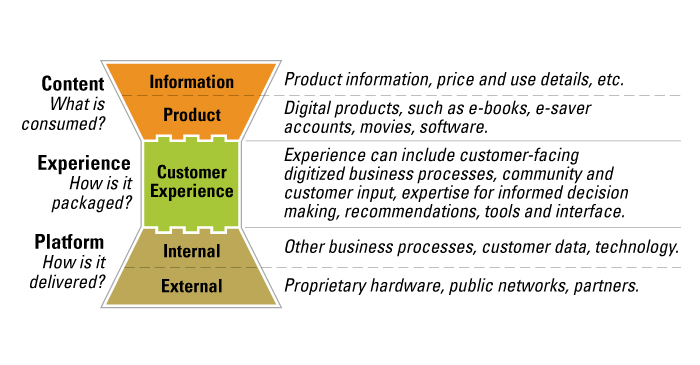
The customer experience embodies what it’s like to be a digital customer of your organization, whether buying digital or physical products. Amazon’s customer experience includes the website and the digitized business processes touching the customer, like the shopping cart and payment options, as well as messaging, such as delivery alerts and email acknowledgments. The experience also includes Amazon’s well-developed customer-created content: customer product ratings and reviews, as well as sophisticated tools like search, a detailed history of purchases and tailored recommendations.
The platform consists of a coherent set of digitized business process, data and infrastructure. The platform has internal and external components and may both deliver digital content to the customer as well as managing physical product delivery to the customer. Amazon’s internal platforms include customer data and all the business processes that don’t touch the customer, such as customer analytics, human resources, finance and merchandising. External platforms include the phones, tablets or computers that consumers use to research and purchase the products, along with telecommunications networks and Amazon’s partnerships with delivery companies like UPS that deliver physical products and generate text messages on delivery; all of these external platforms neatly integrate with Amazon’s internal platforms.
To achieve economies of scale with digital business models requires the development and reuse of digitized platforms across the enterprise.8 Without such shared platforms, the IT units in companies implement a new solution in response to every business need, creating a spaghetti-like arrangement of systems that do meet specific customer needs but are expensive and fragile — and don’t scale enterprise-wide. Worse still, the customer experience suffers as the customer gets a fragmented product-based experience rather than a unified multiproduct experience.
How LexisNexis Strengthened Its Digital Business Model
The experience of LexisNexis, one of the world’s largest providers of information to the legal market, illustrates how one company tackled the challenge of strengthening its digital business model. With 2011 revenues of $2.3 billion, LexisNexis has customers in more than 100 countries, a five-year revenue growth rate of 11%9 and billions of searchable documents. LexisNexis’ operating environment has become increasingly digital; its parent company, Reed Elsevier, reports total enterprise revenues from electronic content and tools increasing from 22% in 2000 to 63% in 2011.10 Leaders at the company expect this will rise to almost 100% in the near future.
As legal content has become more digitized, it has also become more commoditized, and disintermediators such as Bing and Google have gained importance as sources for information such as contact details for lawyers, public records and case law. Governments also are digitizing more of their public records, making them searchable and easier to access. In response, LexisNexis has invested in more exclusive content, improved its customer experience and developed a more flexible platform.
Creating Unique Content
LexisNexis has diversified its content to make it more valuable to lawyers. It continues to deliver public record and case law information in ever more easy-to-find ways. But to create unique content, LexisNexis has developed relationships with top experts — celebrity lawyers — who provide opinions and commentary in many areas such as intellectual property, bankruptcy and constitutional and tax law. These commentaries are updated regularly and received enthusiastically by lawyers practicing in each specialty.
LexisNexis has also been growing its user-generated content. It has agreements with 30 of the top law firms in the United States to generate expert commentary that is syndicated via LexisNexis channels. And it has built relationships with some of the top legal bloggers in America. Common to all these efforts is the creation of unique content not available via any other source.
Improving and Measuring Customer Experience
LexisNexis has invested heavily in its customer experience. Market research based on focus groups and surveys is not getting the job done anymore, so LexisNexis has assembled a team of anthropologists who work closely with customers to identify unmet needs. The field researchers sit with customers and watch, asking them to describe the most frustrating parts of their day, observing the most frequently performed tasks and generating ideas about how to better complete those tasks.
This deep customer-driven innovation has had big impacts at LexisNexis. For example, the process has helped change the product roadmap for LexisNexis’ mobile efforts. The initial mobile strategy was to enable complete mobile access to all LexisNexis services. But the field research led to the insight that customers want to perform quick, time-sensitive tasks on their mobile devices, like tracking time, looking up legal terms and reviewing legal codes and precedents, each via a dedicated app. LexisNexis has deployed more than 15 of these targeted-task mobile apps, with more than 81,000 downloads in the first year.
LexisNexis has also started implementing “trackers” at key customer touchpoints. (A tracker is software that “tracks” a customer’s activity, including browsing and then the decision to purchase or not.) These trackers are used to immediately assess satisfaction and point out problems to be addressed before they affect the overall relationship with LexisNexis — and reduce the company’s reliance on surveys.
Developing a Flexible Global Platform
LexisNexis’ new platform, Lexis Advance, represents a complete update of its technology and processes. Among other elements, it offers an enhanced user experience and includes features such as My Workspace (an online place to access, store and organize legal research), better pre- and post-search filtering, visualization capabilities for research citation and verification, and new linking capabilities. (For example, cases and codes can now be linked to public records, company reports, verdicts and more.) The search capability now encompasses the customer’s content as well as LexisNexis and Web content, and it provides results targeted to the user. (For instance, a lawyer in New York state probably wants Second Circuit cases, not Ninth Circuit cases). The new platform was designed with mobile use in mind, so that data from the mobile apps sync smoothly to the full-featured version. In addition, the platform was designed to be used globally and to include “smart content” and a flexible product platform, enabling innovative applications to be easily added later. (See “LexisNexis’ Digital Business Model.”)
LexisNexis’ Digital Business Model
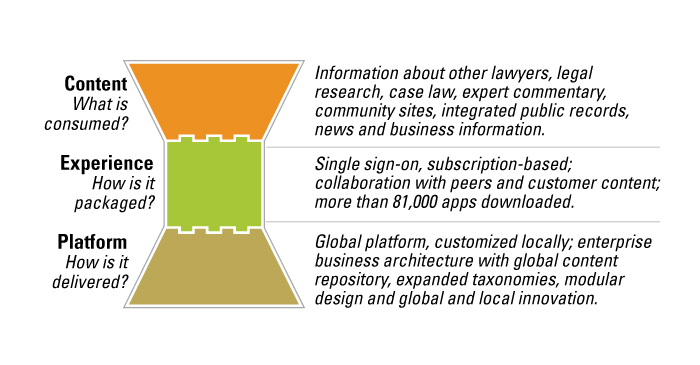
Building Digital Business Model Capabilities
Investing in exclusive content, user experience and an integrated platform has given LexisNexis the ability to enter attractive markets. One of these new markets is the segment of small law firms with one to 50 lawyers. Approximately half of all U.S. lawyers work in small law firms. Small law firms usually don’t need and aren’t able to pay for the same service levels provided to large law firms. LexisNexis added content and services that small law firms need, like lead development, website construction and client and peer ratings. Rather than field-based research, the small law division employs a test-and-learn methodology over the Web — trying new offerings in select markets and scaling what works best.11 LexisNexis’ primary pricing model is based on comprehensive subscriptions. The company also offers subscriptions based on targeted content by geography or practice area, as well as charging by time used.
Like LexisNexis, companies need to choose and invest in their key sources of competitive advantage for their digital business model: content, experience, platform or some combination of those. LexisNexis chose to build strong capabilities in all three to create an industry-leading digital business model that it is scaling globally and adapting to enter adjacent markets. But does every company need to strive to lead its industry in all three capabilities?
What Is Your Digital Source of Competitive Advantage?
We have studied the successful digital business models of companies like Amazon, Apple, Bloomberg, Banco do Brasil, Commonwealth Bank of Australia, DirecTV, ING Direct, Google, Netflix and USAA, and we analyzed the results of a survey of 139 enterprises. For a successful digital business model, your enterprise has to have good content, customer experience and digital platforms. But does your company have to be a leader in all three? We don’t think so — at least not yet.
Consider Apple. The company shipped 125 million iPhones in 2012 and sold more than five million iPhones on the first weekend the iPhone 5 was available.12 In the first quarter of 2012, iPhone sales represented 9% of the handset share, but a whopping 73% of the profit share in the industry.13 The company has created a juggernaut of app content, with more than 700,000 active iPhone apps available14 and cumulative app revenues of approximately $5 billion a year.15 Apple’s annual revenue from apps, music and e-books is projected to be $13 billion in 2013.16
Apple’s customer experience has set a benchmark for all competitors, with easy-to-use interfaces such as iTunes as well as other aspects of the Apple brand magic — making products seen as cool and fun. But it’s the company’s combination of digital platforms — the great design of the physical objects it sells, the engineering of the iTunes platform and the tight integration of the operating systems to the devices — that has been hardest for other companies to replicate.
Today, Apple’s competitive advantage is its customer experience and its platform, not its content; indeed, Apple’s customer experience and platform enable others to provide much of its valuable content. Apple has created a new type of customer experience: the mobile app that has branded and packaged access to great new content. And consumer behavior is changing as a result. As of December 2011, the average U.S. user spends more time inside a mobile app (such as The Wall Street Journal’s iPad app) than on the Web searching.17 This trend has big implications for how to design an effective digital business model and the importance for most companies of having great mobile apps available for customers.
Measuring Effectiveness of Content, Experience and Platform
To better understand digital business models by industry, we surveyed companies to assess the effectiveness of their content, experience and platform. (See “The Effectiveness of Content, Experience and Platform by Industry.”) For each of the three aspects of a digital business model (content, experience and platform), we aggregated the answers to eight or nine survey questions to get a broad base for assessing effectiveness.18
The Effectiveness of Content, Experience and Platform by Industry
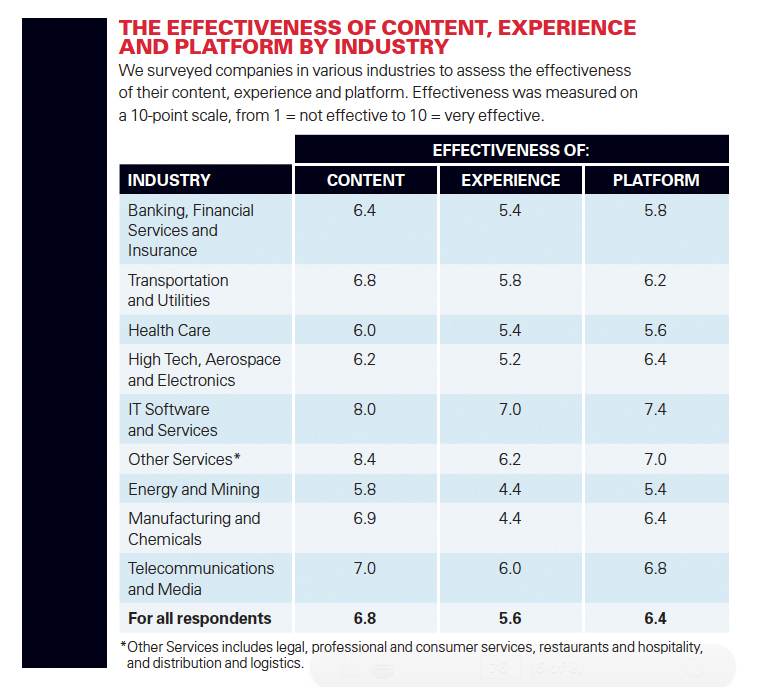
The industry with the strongest effectiveness scores overall was IT software and services, while energy and mining and health care were among the poorest. Interestingly, the top financial performers in each industry also had better digital business model effectiveness. For example in the financial services industry, companies in the top third of financial performers had 29%, 35% and 26% better content, experience and platform scores, respectively, than those in the bottom third.19
But where should you start? That depends on your strategic goals. If your goal is driving new digital revenue, then start with strengthening your digital content (information and/or products) and the associated buzz. If your goal is cross-selling and driving more revenue per customer, focus first on improving your customer experience. If your goal is efficiency and flexibility, then focus first on building and exploiting shared digital platforms.
USAA’s Digital Business Model
For most enterprises that were not born on the Web, creating an effective digital business model is a journey that requires the collaboration of many different parts of the business and often some organizational surgery. Consider USAA, the financial services company based in San Antonio, Texas, that began operations in 1922 to sell insurance policies to military personnel. With eight million members, few branches and content consisting of a complex set of financial products and services, USAA is typically ranked number one in customer experience in its industry. USAA believes that its customer experience is the paramount factor in its success. Consequently, USAA reorganized its channels and call centers, consolidating them into a unified member experience organization focused on life events rather than products. Typical life events are buying a house or a car, having a baby or getting married. When USAA members go to the company’s website (or call the company), they can pick a life event and are then offered an integrated set of products associated with that life event. To manage this organizationally, a customer experience executive vice president reports to the CEO and supervises 12,000-plus customer service representatives. To deliver the content and experience, USAA has a single customer information file and shared infrastructure, data and application services (its platform). The results have been significant.
We believe USAA has very good products and platforms, but the company’s competitive advantage — and what drives the company’s success — is having the best customer experience. As a result, USAA has restructured to focus its digital business model — indeed, the entire business model — on delivering great customer experience.
The Journey From Place to Space
Some industries are moving more quickly from place to space. For example, media is probably leading the way — and watching how that industry has struggled to get paid for content is sobering for the industries that are now making the journey from place to space. Retail and financial services are not far behind media. Both industries have players with significant investments in physical channels (such as Target Brands Inc.), with newer entrants that are all or mostly competing via digital channels (such as Amazon). A poignant Wall Street Journal article reported Target’s frustration at being used as a showroom in which customers view products but then buy those products for less online from companies that don’t have Target’s physical infrastructure costs.20 One of Target’s responses was to ask vendors’ help in developing unique products that would reduce the easy price comparison using bar codes and online search.
Where are your industry and your company on the journey from place to space? It’s a good time to review your digital business model. As we have seen in the move from print books to digital, once a tipping point is reached, the movement to space speeds up and is hard to resist. Just look at the demise of many physical bookstores. Other industries will follow — at different paces, driven, in part, by issues such as regulation, product complexity and how amenable the products are to digitization. Even in industries like health care that traditionally rely on the physical interaction between provider and patient, we are seeing more online services: Doctors are providing email advice and remote monitoring of patients, and insurance companies are enabling online claims with more and more self-service. The move from place to space and the need for a digital business model are not just phenomena limited to the consumer market, either, as we saw in the case of a business-to-business enterprise, LexisNexis.
To further develop and assess your own enterprise’s digital business models, we suggest you think about the business value of your content, experience and platform today (by business unit and/or major customer segment) as well as what you expect three years from now. (See “Assessing Your Digital Business Model.”) Get as many colleagues as you can to assess your digital business model. As you consider the future importance of content, experience and platform in your business, we have a final question: Does your budget for next year reflect the importance of content, experience and platform? And how do you govern this? Now’s the time to take the lead on strengthening your digital business model — as your customers and enterprise move from place to space.
References
1. ClickFox, “Mobile Apps Consumer Survey,” October 2011 (sample size=650). The survey also found that 78% of the sample reported using apps to interact with companies with which they do business, like banks and retailers.
2. The concept of a digital business model draws on previous research on business models, much of which focused on e-business. The numerous definitions of a business model all include some form of how a business makes money or sustains itself. Our previous work on business models is described in T.W. Malone, P. Weill, R.K. Lai, V.T. D’Urso, G. Herman, T.G. Apel and S. Woerner, “Do Some Business Models Perform Better Than Others?” MIT Sloan Research Paper No. 4615-06, May 2006; performance differences between business models are highlighted in P. Weill, T.W. Malone and T.G. Apel, “The Business Models Investors Prefer,” MIT Sloan Management Review 52, no. 4 (summer 2011): 17-19. Additional recent books on business models include: A. Osterwalder and Y. Pigneur, “Business Model Generation: A Handbook for Visionaries, Game Changers, and Challengers” (Hoboken, New Jersey: Wiley, 2010); S. Kaplan, “The Business Model Innovation Factory: How to Stay Relevant When the World Is Changing” (Hoboken, New Jersey: Wiley, 2012); “Harvard Business Review on Rebuilding Your Business Model” (Boston, Massachusetts: Harvard Business Press, 2011); M.W. Johnson, “Seizing the White Space: Business Model Innovation for Growth and Renewal” (Boston, Massachusetts: Harvard Business Press, 2010); and H. Chesbrough, “Open Business Models: How to Thrive in the New Innovation Landscape” (Boston, Massachusetts: Harvard Business Press, 2006).
3. Year-to-year revenue growth, 2nd quarter, 2011. Source: Netflix Q2 2011 Letter to Shareholders.
4. MIT CISR conducted a digital business models survey in 2011 (sample size=118). We measured a number of digital practices that were part of either content effectiveness, customer experience effectiveness or platform effectiveness constructs. The survey included nine questions about content effectiveness, nine about experience effectiveness and eight about platform effectiveness. Effectiveness was measured on a 10-point scale, from 1=Not effective to 10=Very effective. To assess total digital effectiveness, we averaged two outcomes scales: “attractiveness of digital products” and “effectiveness of digital delivery.” In this article, we highlight the 10 practices (out of 27) that were statistically significant (p<0.1) in a regression against digital effectiveness. In other analyses, we correlated content effectiveness, customer experience effectiveness and platform effectiveness with financial performance measures, adjusted for industry.
5. For one of the earliest and most insightful discussions of this move from place to space, see J.F. Rayport and J.J. Sviokla, “Managing in the Marketspace,” Harvard Business Review 74, no. 2 (November-December 1994): 141-150.
6. Framework adapted from P. Weill and M.R. Vitale, “Place to Space: Migrating to eBusiness Models” (Boston: Harvard Business Press, 2001) and Rayport and Sviokla, “Managing in the Marketspace.”
7. C.C. Miller and J. Bosman, “E-Books Outsell Print Books at Amazon” New York Times, May 19, 2011.
8. For more on platforms, see P. Weill and J.W. Ross, “IT Savvy: What Top Executives Must Know to Go From Pain to Gain” (Boston: Harvard Business Press, 2009).
9. Financial growth rate calculated by MIT CISR, based on public data.
10. Reed Elsevier, “Annual Reports and Financial Statements” (London: 2011).
11. For more on test and learn, see E.T. Anderson and D. Simester, “A Step-by-Step Guide to Smart Business Experiments,” Harvard Business Review 89, no. 3 (March 2011): 98-105.
12. Apple Inc., “Q4 2012 Unaudited Summary”; and Apple Inc., “iPhone 5 First Weekend Sales Top Five Million.”
13. Z. Epstein, “Apple Owns 8.8% of Cell Phone Market, 73% of Cell Phone Profits,” BGR, May 3,, 2012.
14. C. Taylor, “Apple Sets All-Time Record for Quarterly App Store Sales: 700K Apps, 275K for iPad, $6.5B Paid to Devs,” TechCrunch, Oct. 25, 2012.
15. Piper Jaffrey estimate cited in J. Lowensohn, “Despite Growth, Google Trails Apple in App Dollars Spent,” Nov. 21, 2011.
16. M. Brian, “Apple iTunes Revenues to Push $13 Billion in 2013: Report,” The Next Web, July 5, 2011.
17. BI Intelligence using sources from comScore, Alexa, U.S. Bureau of Labor Statistics and Flurry: see Business Insider, “BII Report: Why Mobile Commerce Is Set to Explode,” Jan. 30, 2013.
18. Questions include “How often does your enterprise contract with third parties to measure your external customer digital experience?” and “Relative to competitors, how effective is the digital information you provide about your non-digital products and services in retaining or attracting external customers?”
19. We measured financial performance using an equally weighted combination of revenue growth and net margin percentage adjusted for industry. We asked respondents to provide their revenue growth and net margin percentages and then subtracted the respective industry average from each company’s data (to industry adjust). Then we took z-scores of both measures (to place the different measures on the same scale) and summed the two to get a combined measure of revenue growth and profitability.
20. A. Zimmerman, “Showdown Over ‘Showrooming,’” Wall Street Journal, Jan. 23, 2012.
i. J.W. Ross and C.M. Beath, “USAA: Organizing for Innovation and Superior Customer Services,” MIT CISR Working Paper No. 382, December 2010.
Acknowledgments
The authors wish to acknowledge, with gratitude, that important contributions to this research came from Jeanne Ross, Peter Reynolds, Michele Vivona and John Sviokla, as well as the many executives who enthusiastically provided feedback during MIT CISR workshops.


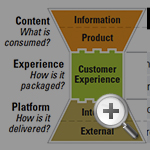 View Exhibit
View Exhibit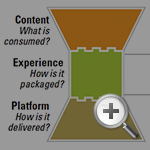 View Exhibit
View Exhibit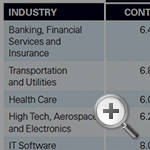 View Exhibit
View Exhibit
Comments (10)
Md. Shaheen Sohel
Margarita Lopez
Jacques Gaumond, ACC, Acc.Dir.
Liliana Duffy
Tim McMann
Stephanie Woerner
Mike Tiburzi
Christopher Rollyson
Anderson Uvie-Emegbo
kathleen.held